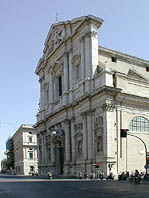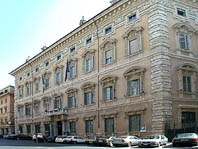|
St. Andrea della Valle
 (1665, Carlo Maderno, Carlo Rainaldi, Carlo Fontana). The hero of Tosca is painting in this church in the opening scene of Puccini's opera. (1665, Carlo Maderno, Carlo Rainaldi, Carlo Fontana). The hero of Tosca is painting in this church in the opening scene of Puccini's opera.
After St. Peter's, this dome is the second highest in Rome.
This Baroque giant dominates the central span of busy Corso Vittorio Emanuele, but you won't find many people going into it. If you do enter, be sure to compare the ceiling paintings by Domenichino (1581-1641) with those of his rival, Giovanni Lanfranco (1582-1647). The latter did the brilliant and innovative "trompe l'oeil" fresco of the Glory of Paradise in the dome, the earliest 17C illusionist cupola painting, which influenced subsequent Baroque masters.
Domenichino had previously executed the fresco cycle of the life of St. Andrew in the vault of the choir, in a very traditional, static style.
But after he had seen Lanfranco's exuberant dome, Domenichino painted the pendentives of the dome with frescoes of the four Evangelists in a style so vigorous that they have been compared to Michelangelo's Sistine Ceiling.
The famous feature of the facade is the single stone angel half way up the left side, of which there is no pendant on the other side to provide symmetry. The sculptor Ercole Ferrato, hearing that Pope Alexander VII had criticized his first angel, swore "If he wants another, let him make it himself!"
Piazza Sant’Andrea della Valle (Map G 6)
Palazzo Madama
 (1610, Paulo Maracelli and Ludovico Cardi). Named after an early tenant, the bastard daughter of Emperor Charles V of Austria who married Alessandro de' Medici but whose title was simply Madame. (1610, Paulo Maracelli and Ludovico Cardi). Named after an early tenant, the bastard daughter of Emperor Charles V of Austria who married Alessandro de' Medici but whose title was simply Madame.
She had inherited the earlier palace of Catherine de Medici who lived here before going off to Paris where she married Henri II and introduced fine cuisine to the transalpine barbarians.
The Baroque facade and enlarged wings surround an ornate chamber which has housed the Senate of the Italian Republic since unification in 1871.
Corso del Rinascimento. Tel. 06 67061. (Map F 5)
Open first Saturday of each month 10 am – 6 pm
Palazzo Venezia
Is a massive building dominating the square of the same name. Mussolini harangued the crowds in the 1930s from the central balcony (and then stepped back into his gigantic office for a gallant encounter with Clara Pettacci, his adoring teenage mistress, who would be waiting for him on a nearby "chaise longue").
Palazzo Venezia
History
1455. Sometimes called the first Renaissance building in Rome it was half fortress, half palace, with a large tree-filled courtyard inside, and incorporating the church of St. Marco.
1564. It became the Venetian Ambassadors' residence.
1814. Austria, conqueror of the Veneto, now had it's Ambassador living here.
1916. The Italian state repossessed the building, which came to be Mussolini's offices, during the Fascist era. To impress Hilter, he had the medieval quarter between this square and the Colosseum torn down so that that great symbol of Rome's imperial might would be visible from the balcony. ("All this", with a deprecating sleight of hand," is mine....").
|
Via del Plebiscito, 118 - Corner Piazza Venezia (Map H 6)
|
|
 (1665, Carlo Maderno, Carlo Rainaldi, Carlo Fontana). The hero of Tosca is painting in this church in the opening scene of Puccini's opera.
(1665, Carlo Maderno, Carlo Rainaldi, Carlo Fontana). The hero of Tosca is painting in this church in the opening scene of Puccini's opera. (1610, Paulo Maracelli and Ludovico Cardi). Named after an early tenant, the bastard daughter of Emperor Charles V of Austria who married Alessandro de' Medici but whose title was simply Madame.
(1610, Paulo Maracelli and Ludovico Cardi). Named after an early tenant, the bastard daughter of Emperor Charles V of Austria who married Alessandro de' Medici but whose title was simply Madame.